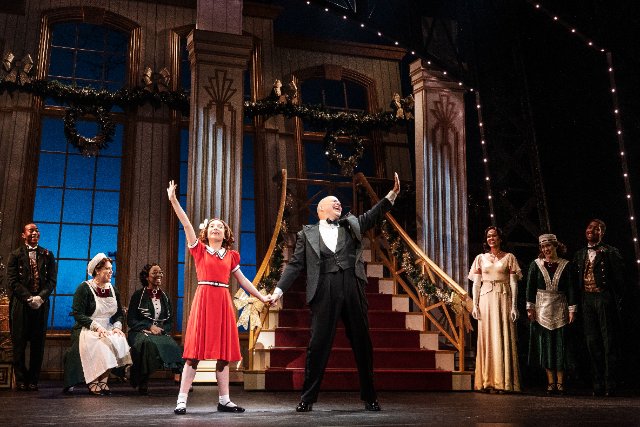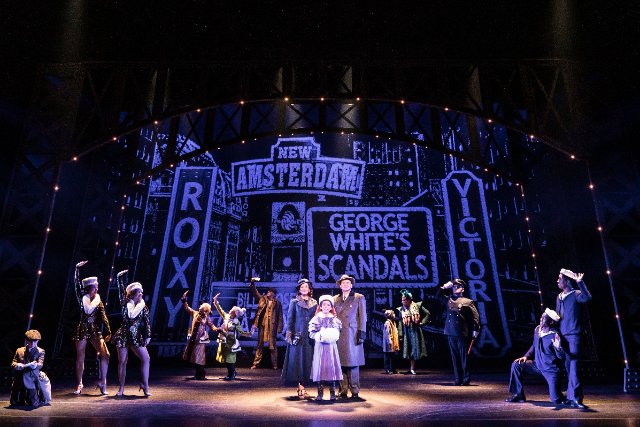Annie on Tour
Non-equity tour plays Ft. Lauderdale
By: Aaron Krause - Oct 13, 2023
In the irresistible, new, non-equity national touring production of Annie, the orphans circle Miss Hannigan like vultures. Then, they unload garbage on her as though she were a dump. This causes her to wiggle as though cockroaches are crawling on her.
On the contrary, as the titular character, a radiant, red-headed child actress named Rainier “Rainey” Treviño leaps right into our hearts. And she heaps on us plenty of helpings of hope and happiness. Certainly, Treviño has a magnetic effect on us. In particular, she draws audiences to such qualities as the titular orphan’s charm, charisma, compassion, optimism, precociousness, and determination.
Treviño, often flashing a wide and bright smile, doesn’t portray Annie; she becomes the titular character and inhabits America’s favorite female orphan.
In addition to demonstrating all of Annie’s requisite qualities, Treviño displays a naturalness and stage presence that is rare in performers so young. Also, she possesses a clear, strong, and expressive voice. And she deftly controls it to hold high, long notes such as the word “Way” at the end of “Tomorrow.” Treviño shines as she sings this recognizable, unforgettable anthem of optimism.
This heartwarming and energetic production is playing the Broward Center for the Performing Arts in Ft. Lauderdale through Oct. 22. It then heads to Orlando’s Dr. Phillips Center for the Performing Arts from Oct. 24-29 before leaving the Sunshine State.
Truly, this mounting of Annie reminds us anew that, when we need to spend a couple of hours with the titular character, she comes ready with her winning traits. During these dark days, we need Annie Warbucks more than ever.
Indeed, on this national tour’s website, an advertisement notes that this “best-loved musical of all time returns in a new production – just as you remember it and just when we need it most.” Doubtless, Annie (the character and the musical) is a most welcome sight, sound, and presence with everything going wrong in the world. And, yes, this production offers the same “Annie” that your grandparents grew up watching.
For the few who may be unfamiliar with Annie, the musical’s basis is the Little Orphan Annie comic strip that appeared in the papers from 1924. With the strip, author Harold Grey introduced us to a red-headed, curly-haired, plucky orphan living in a New York City orphanage in the 1930s. No matter how grim things seem for her, she remains optimistic and fearless. The musical opened on Broadway in 1977, and earned 11 Tony Award nominations, ultimately winning for Best Musical, Score, and Book. Understandably, the show has delighted folks across the world ever since.
Frankly, this production does not present anything “new.” But director Jenn Thompson, who portrayed Pepper in the original Broadway production in 1977, wisely trusts the material. There are preciously few, near-perfect things that you just don’t mess with. And when it comes to musical theater, Annie delivers in many areas. For instance, an adorable dog (yes, this production includes a real one), sympathetic characters, including loveable children, a hope-infused story, and songs to whose melodies we hum to even in our sleep, and a happy ending are all present in this touring production.
But in order for us to fully feel the deep relief at that ending, a director of Annie needs to include darkness. Specifically, we need to fear for the titular orphan and hope that she won’t end up with the villains – or worse. Fortunately, at times, Thompson darkens the proceedings enough to make us pull for the title orphan and her friends to end up in good hands.
One of the first things we see on stage after the curtain rises is an old, unsightly, decaying structure. We assume it is the entrance to the girls’ annex of the New York Municipal Orphanage. Wilson Chin, who designed the deftly contrasting sets, includes the structure as part of the orphanage. As we look at it dreariness, we hope for better things for the titular orphan and her friends. Also, early on, colors such as black and grey, fog, and smoke reinforce the dismal surroundings early on.
Altogether, the orphanage is basic, furnished with the kind of beds you might find in a jail. And then there is Miss Hannigan. As Stefanie Londino portrays her, she is a cranky, at-times menacing force. She leans threateningly into the orphans when they cross her. Also, Londino credibly conveys exasperation and weariness. These qualities suggest that someone left her with these unwanted urchins so many years ago and she wishes to get rid of them, as though they were maggots. Surely, we keenly sense Hannigan’s irritation during the number, “Little Girls.” Londino sings it with exasperation.
This production also offers grimness during a dreary scene with the Hoovervilles. As you may know, they are a group of homeless people. And they epitomize the working-class folks affected most by President Herbert Hoover’s policies and the depression. In the scene, the titular orphan showers the scene with light as radiant as a bright sun suddenly shining amid stormy clouds. Deftly, the performers portraying the Hoovervilles sing their number, “We’d Like to Thank You” with sarcasm and anger, suggesting their feelings toward Hoover.
With a similar angry tone, the titular orphan and her friends sing “It’s the Hard Knock Life.”
However, life hasn’t been much better for Hannigan’s crooked brother, “Rooster” Hanigan and his ditzy girlfriend, Lilly St. Regis. The actors playing the couple, as well as Londino, deliver a flashy rendition of “Easy Street,” the metaphorical location in which they hope to end up.
Jeffrey T. Kelly properly imbues Rooster with a mobster-like toughness and hints of flashiness, confidence, and shadiness. As for his ditzy, blonde girlfriend, Lily, Samantha Stevens turns her into a caricature with a voice that mostly sounds like Mickey Mouse. True, the exceptions are when Lilly pretends to be Annie’s real mother and Rooster her biological father. During these scenes, the couple are believably grateful and convincing as loving parents.
Of course, the real father figure in the show is Oliver “Daddy” Warbucks. He is the billionaire owner of factories who lives in Fifth Avenue, mostly alone. He invites her over for Christmas — and the two become inseparable.
The strong chemistry between Treviño and Christopher Swan’s Warbucks is touching. For example, as Warbucks carries Annie home for the movies, he looks as though she were his daughter from day one. The two performers also waltz to music and caress each other like a real dad and daughter.
At first, Swan infuses Warbucks with a business-like demeanor. It suggests that he has no time for children. And it’s always puzzled me why he says, “Orphans are boys” (surely, this worldly man should know better). But it takes little time for Swan’s Warbucks to turn into a loving and warm father figure who comes to recognize the truly important things in life. Yes, the titular orphan has that effect on people.
She also wins over Grace Farrell, Warbucks’ personal secretary whom Julia Nicole Hunter imbues with, well, grace, polish, and compassion.
Hunter and performers portraying staff at Warbucks’ mansion deliver a rousing “You Won’t Be an Orphan for Long.” As they sing it, the number starts slowly and builds in intensity and energy. It is easy to believe them that Warbucks will make sure that Annie doesn’t remain an orphan. With his mission clear, Warbucks enlists the help of President Roosevelt (a charming, positive Mark Woodard). Truly, such characters leave us wishing that politicians these days can unite and get along as well as Warbucks, a staunch Republican, and the Democratic Roosevelt.
Speaking of Warbucks and his mansion, Chin, the set designer, deftly differentiates that big residence with the clumsy, dark orphanage. Indeed, the mansion, with colors such as a rich brown, is spacious, regal and opulent compared to the dump that is the orphanage.
Similarly, costume designer Alejo Vietti sets apart the poorer characters from the wealthier folks by how they dress. And Philip S. Rosenberg’s work enhances the darkness and cheeriness of scenes with his work as lighting designer.
Under music supervisor Matthew Smedal, a vibrant, live orchestra accompanies the performers in song. They do so at a volume that allows the audience to hear and understand the performers’ clear, strong, and expressive voices. Minor characters with a solo include radio personality Bert Healy (a pleasant-voiced Kaleb Jenkins). And to their credit, the performers playing Annie’s fellow orphan friends are energetic and rambunctious around Miss Hannigan.
Director Thompson deftly paces the production. In fact, it seems to fly by. Fortunately, sincere, touching moments have time to truly land. In addition, Thompson milks the script for all the comedy she can squeeze out of it. As a result, we laugh, such as when someone mentions that before you know it, Annie will end up in the funny papers. It’s the kind of humor that has endeared so many to this show.
Thompson’s direction also includes impactful pauses. In addition, she places the performers into positions that make sense. For instance, at one point, the characters surround the titular orphan seated on a throne-like chair. It is as though she were royalty. Then, one of the characters hoists Annie on his shoulders. Clearly, they all adore her…and doubtless, we do, too.
Before the curtain rises, we see what looks like one of New York City’s famed bridges. It is easy to spot two dark underground tunnels as well as net-like structures. But if you look up, you will notice an American flag. The symbolism is apparent; often, we must look up and keep hope to discover the light at the end of the tunnel.
A new non-equity national touring production of Annie remains in Ft. Lauderdale through Oct. 22. The venue is the Broward Center for the Performing Arts, 201 S.W. 5th Ave. in Ft. Lauderdale. For tickets and more information, go to Annie | Broward Center for the Performing Arts or Tour Dates – Annie (annietour.com).


